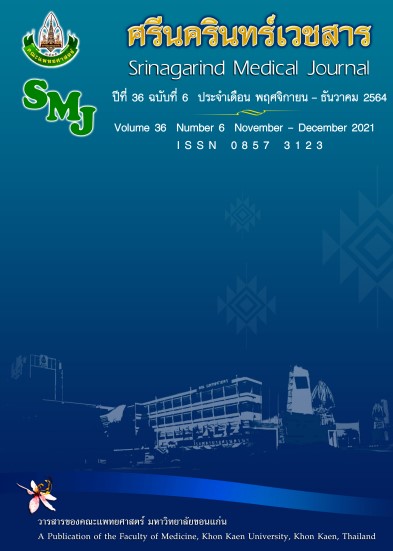ความรู้ของนิสิตแพทย์ในการวินิจฉัยและตรวจประเมินความพิการทางการเคลื่อนไหวหรือทางร่างกาย
คำสำคัญ:
Key words: Assessment of Physical Disability; Medical Student; Rehabilitation Medicineบทคัดย่อ
บทคัดย่อ
หลักการและวัตถุประสงค์: พระราชบัญญัติส่งเสริมและพัฒนาคุณภาพชีวิตคนพิการ พ.ศ.2550 กำหนดให้แพทย์มีหน้าที่ในการวินิจฉัยและตรวจประเมินความพิการทางการเคลื่อนไหวหรือทางร่างกาย แต่หลักสูตรแพทยศาสตรบัณฑิตยังให้ความสำคัญในประเด็นนี้ค่อนข้างน้อย ดังนั้น งานวิจัยนี้จึงมีวัตถุประสงค์เพื่อศึกษาระดับความรู้ของนิสิตแพทย์ในการวินิจฉัยและตรวจประเมินความพิการทางการเคลื่อนไหวหรือทางร่างกาย และศึกษาทัศนคติของนิสิตแพทย์ที่มีต่อผู้พิการ
วิธีการศึกษา: เป็นการศึกษาเชิงพรรณนาแบบตัดขวาง ผู้ให้ข้อมูล คือ นิสิตแพทย์ชั้นปีที่ 6 จำนวน 45 ราย จากเครือข่ายคณะแพทยศาสตร์ มหาวิทยาลัยนเรศวร 3 แห่ง ได้แก่ โรงพยาบาลสมเด็จพระเจ้าตากสินมหาราช โรงพยาบาลแพร่ และโรงพยาบาลพิจิตร ปีการศึกษา 2562 เครื่องมือที่ใช้เป็นแบบสอบถามที่ออกแบบโดยผู้วิจัย สถิติที่ใช้ในงานวิจัย ได้แก่ จำนวน ร้อยละ ค่าเฉลี่ยและส่วนเบี่ยงเบนมาตรฐาน
ผลการศึกษา: ผู้ตอบแบบสอบถามทั้งหมด 39 ราย (ร้อยละ 88.64) เคยผ่านการเรียนรู้ทักษะการประเมินความพิการ ร้อยละ 64.10 สำหรับความรู้ของนิสิตแพทย์ในการวินิจฉัยและตรวจประเมินความพิการส่วนมากอยู่ในระดับปานกลาง (ร้อยละ 69.23) ส่วนปัจจัยด้านการเคยผ่านการเรียนวิชาเวชศาสตร์ฟื้นฟูและปัจจัยด้านการรับรู้ถึง พรบ.ส่งเสริมและพัฒนาคุณภาพชีวิตคนพิการ พ.ศ.2550 พบว่ามีความสัมพันธ์กับความรู้ของนิสิตแพทย์ในการวินิจฉัยและตรวจประเมินความพิการอย่างมีนัยสำคัญทางสถิติที่ 0.05 อีกทั้ง ทัศนคติของนิสิตแพทย์ที่มีต่อผู้พิการ ได้แก่ ผู้พิการเป็นประชาชนที่มีสิทธิเท่าเทียมผู้อื่น (ร้อยละ 94.88) รองลงมา ผู้พิการคือกลุ่มบุคคลที่ควรได้รับโอกาสทางสังคม (ร้อยละ 58.97) และผู้พิการคือผู้ป่วยที่ต้องได้รับการดูแลรักษา (ร้อยละ 43.58) ตามลำดับ
สรุป: นิสิตแพทย์ส่วนใหญ่มีความรู้ในการวินิจฉัยและตรวจประเมินความพิการทางการเคลื่อนไหวหรือทางร่างกายที่ระดับปานกลางและมีทัศนคติในแง่บวกต่อผู้พิการ อย่างไรก็ตาม โรงเรียนแพทย์ควรปรับปรุงหลักสูตรให้เอื้ออำนวยต่อทักษะทางวิชาชีพให้มากยิ่งขึ้น
คำสำคัญ: ประเมินความพิการ; นิสิตแพทย์; รายวิชาเวชศาสตร์ฟื้นฟู
Background and Objective: The Empowerment of Persons with Disabilities Act, B.E.2550 set guidelines for physicians who have responsibility for diagnosis and assessment of persons with physical disability. But, the Doctor of Medicine and related health professional education programs give little importance to this issue. Therefore, this research was designed to study medical students’ knowledge levels diagnosis and assessment of physical disability and their attitude toward physical disability.
Method: This was a descriptive cross-sectional study. Informants were 45 6th year medical students from 3 network schools of the Faculty of Medicine, Naresuan University including: Phrae, Phichit & Somdejphrajaotaksinmaharaj. The study was carried out in the 2019 academic year. The instrument was a questionnaire designed by the researcher. Descriptive statistics used were frequency , percentage, mean and S.D.
Result: The response rate was 88.64% (39 of 45 medical students returned the questionnaire), and 64.10% had learned about disability assessment skills. The students knowledge on diagnosis and assessment of physical disability was mostly at the moderate level (69.23%). Experience in rehabilitation medicine andknowledge of the Empowerment of Persons with Disabilities Act were significantly related to the students knowledge of diagnosis and assessment of physical disability. Medical students’ attitudes toward persons with physical disability included: disabled persons had equal rights to others (94.88%), were groups who should receive social opportunities (58.97%) and were patients who needed treatment (43.58%), respectively.
Conclusion: Most medical students had moderate knowledge on diagnosis and assessment of physical disability and had positive attitudes towards persons with disabilities. However, medical schools should improve their curriculum to promote professional skills and knowledge in this area.
Key words: Assessment of Physical Disability; Medical Student; Rehabilitation Medicine




